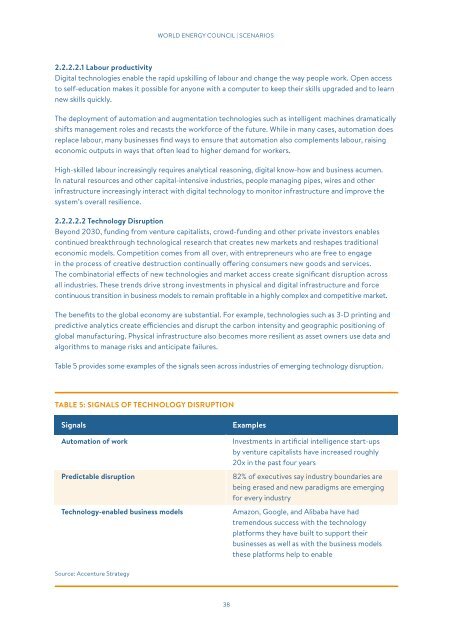World Energy Scenarios
b9Sz9NC
b9Sz9NC
Create successful ePaper yourself
Turn your PDF publications into a flip-book with our unique Google optimized e-Paper software.
WORLD ENERGY COUNCIL | SCENARIOS<br />
2.2.2.2.1 Labour productivity<br />
Digital technologies enable the rapid upskilling of labour and change the way people work. Open access<br />
to self-education makes it possible for anyone with a computer to keep their skills upgraded and to learn<br />
new skills quickly.<br />
The deployment of automation and augmentation technologies such as intelligent machines dramatically<br />
shifts management roles and recasts the workforce of the future. While in many cases, automation does<br />
replace labour, many businesses find ways to ensure that automation also complements labour, raising<br />
economic outputs in ways that often lead to higher demand for workers.<br />
High-skilled labour increasingly requires analytical reasoning, digital know-how and business acumen.<br />
In natural resources and other capital-intensive industries, people managing pipes, wires and other<br />
infrastructure increasingly interact with digital technology to monitor infrastructure and improve the<br />
system’s overall resilience.<br />
2.2.2.2.2 Technology Disruption<br />
Beyond 2030, funding from venture capitalists, crowd-funding and other private investors enables<br />
continued breakthrough technological research that creates new markets and reshapes traditional<br />
economic models. Competition comes from all over, with entrepreneurs who are free to engage<br />
in the process of creative destruction continually offering consumers new goods and services.<br />
The combinatorial effects of new technologies and market access create significant disruption across<br />
all industries. These trends drive strong investments in physical and digital infrastructure and force<br />
continuous transition in business models to remain profitable in a highly complex and competitive market.<br />
The benefits to the global economy are substantial. For example, technologies such as 3-D printing and<br />
predictive analytics create efficiencies and disrupt the carbon intensity and geographic positioning of<br />
global manufacturing. Physical infrastructure also becomes more resilient as asset owners use data and<br />
algorithms to manage risks and anticipate failures.<br />
Table 5 provides some examples of the signals seen across industries of emerging technology disruption.<br />
TABLE 5: SIGNALS OF TECHNOLOGY DISRUPTION<br />
Signals<br />
Automation of work<br />
Predictable disruption<br />
Technology-enabled business models<br />
Examples<br />
Investments in artificial intelligence start-ups<br />
by venture capitalists have increased roughly<br />
20x in the past four years<br />
82% of executives say industry boundaries are<br />
being erased and new paradigms are emerging<br />
for every industry<br />
Amazon, Google, and Alibaba have had<br />
tremendous success with the technology<br />
platforms they have built to support their<br />
businesses as well as with the business models<br />
these platforms help to enable<br />
Source: Accenture Strategy<br />
38


